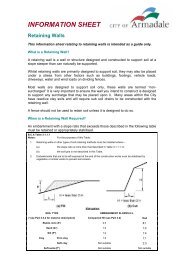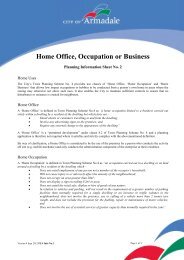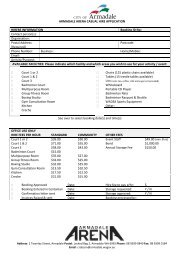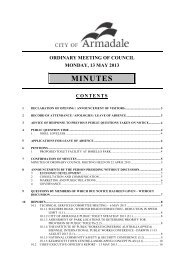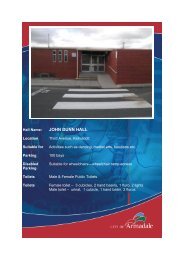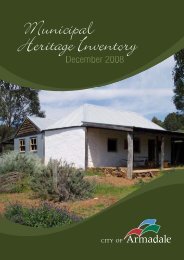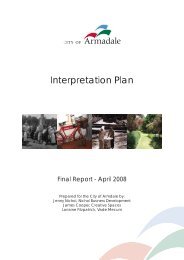Public Toilet Strategy 2013 - City of Armadale
Public Toilet Strategy 2013 - City of Armadale
Public Toilet Strategy 2013 - City of Armadale
Create successful ePaper yourself
Turn your PDF publications into a flip-book with our unique Google optimized e-Paper software.
9.2 Comparative Analysis<br />
The <strong>City</strong> <strong>of</strong> <strong>Armadale</strong>’s peer group/neighbouring Council’s policies/practices have also been reviewed in<br />
order to establish key trends and best practice for specific aspects <strong>of</strong> public toilet provision. For the purposes<br />
<strong>of</strong> this report, the peer council group comprised <strong>City</strong> <strong>of</strong> Gosnells, <strong>City</strong> <strong>of</strong> Cockburn, <strong>City</strong> <strong>of</strong> Canning and Shire<br />
<strong>of</strong> Kalamunda.<br />
9.2.1 <strong>City</strong> <strong>of</strong> Gosnells<br />
The <strong>City</strong> <strong>of</strong> Gosnells does not have a <strong>Public</strong> <strong>Toilet</strong> <strong>Strategy</strong> for their 13 (approx.) public toilets <strong>of</strong> which one is<br />
a composting type located in the hills area, which exudes a pungent odour and another that is fully<br />
automated. The latter incurs high maintenance costs given that specialist repairers are required, not a<br />
standard plumber. Currently the <strong>City</strong> is changing over to lightless, windowless, stainless steel, and seat less<br />
systems with the cistern placed in ducts and the toilet roll holders in locked containers. Most toilets are<br />
cleaned and inspected daily except those in high use areas, which may be cleaned twice a day. All external<br />
doors are protected by security cages. The measures the <strong>City</strong> has adopted has restricted vandalism to a<br />
“limited” status.<br />
9.2.2 <strong>City</strong> <strong>of</strong> Cockburn<br />
The <strong>City</strong> <strong>of</strong> Cockburn does not have a <strong>Public</strong> <strong>Toilet</strong> <strong>Strategy</strong> nor do they have any automated toilets amongst<br />
their eight stand-alone public toilets. Except in vandalism “hot spots” toilets are open 24 hours per day, the<br />
excepted locations open at 6am and close at 8pm or 9.30pm winter and summer respectively. Vandalism is<br />
on average at a medium to high level. In high usage locations, stainless steel pans are preferred but<br />
traditional porcelain elsewhere.<br />
9.2.3 <strong>City</strong> <strong>of</strong> Canning<br />
The <strong>City</strong> does not have a <strong>Public</strong> <strong>Toilet</strong> <strong>Strategy</strong> for their 12 (approx.) public toilets. It has also historically<br />
avoided automated and stainless steel opting for what it feels is the more cost effective porcelain toilet pans<br />
and it will continue with its current management regime. Whilst there are some “hot spots” concerning<br />
vandalism, in the main such is at a manageable level.<br />
9.2.4 Shire <strong>of</strong> Kalamunda<br />
The Shire does not have a <strong>Public</strong> <strong>Toilet</strong> <strong>Strategy</strong> nor do they have any toilet amongst their twelve standalone,<br />
traditional style public toilets which is connected to water-borne deep sewer. All public toilets are<br />
connected to conventional septic tanks with leach drains. Although three vandalism “hot spots” were<br />
identified by the Shire, the level <strong>of</strong> vandalism is considered to be average.<br />
9.3 Range <strong>of</strong> options to deliver the service<br />
How local authorities function and the cost <strong>of</strong> directly employed and/or contract services has also changed<br />
significantly. Labour is no longer a cheap asset. The base cost and on-costs <strong>of</strong> employing a toilet attendant<br />
are prohibitive, as are other labour costs, which, in some cases, outweigh the cost <strong>of</strong> the ‘seat itself’.<br />
Often a suggested solution is to charge the public, who use the facilities. However, charging for these<br />
facilities is a complex matter. There is public resistance to charging, particularly if the facilities are not then in<br />
pristine condition. In many circumstances, the cost <strong>of</strong> collecting, counting and transporting the money as<br />
well as the minor discouragement to those who would wish to misuse the facility, prove this option not to be<br />
enduring and certainly not acceptable for a service that many users already believe should be free.<br />
Another course <strong>of</strong> action for the local authorities is Community <strong>Toilet</strong> Schemes (CTS). The local government<br />
work in partnership with local businesses to provide access for the public to clean, safe toilets and may<br />
Page 8




